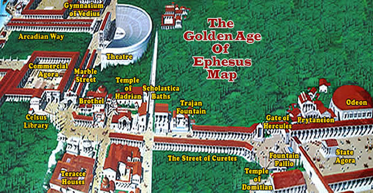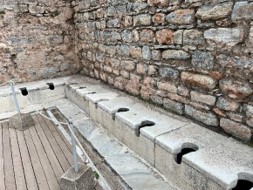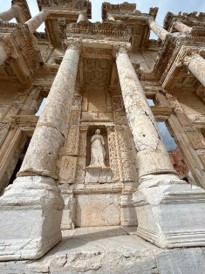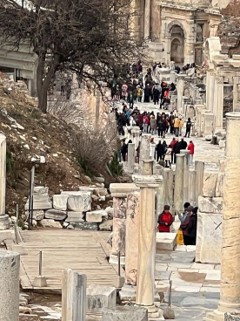“Find him.”
The slave’s eyes flared wide, exposing the whites. “It is—.”
“Impossible. I know.” Sabina let her hands drop, imagining the hundreds of children
begging in the streets of the teeming metropolis, the third-largest city in Domitian’s Roman
Empire. The boy would have melded into the crowds of Ephesus, indistinguishable in a filthy
lice-infested tunic and bare feet.
– Excerpt from book two in the Secrets of Ephesus series “Fortunes of Death”
 When the Secrets of Ephesus books took place, large Roman cities were the envy of all the “known” world and continued unrivaled for hundreds of years. Roman provincial cities such as Miletus, Pergamon, and Ephesus competed to be the center of government for their province. One way to convince Rome that their city deserved the honor and benefits of being the Roman governor’s capital city and residence was to invest in its infrastructure.
When the Secrets of Ephesus books took place, large Roman cities were the envy of all the “known” world and continued unrivaled for hundreds of years. Roman provincial cities such as Miletus, Pergamon, and Ephesus competed to be the center of government for their province. One way to convince Rome that their city deserved the honor and benefits of being the Roman governor’s capital city and residence was to invest in its infrastructure.
Much like cities today competing for large companies or sports facilities to locate in their communities, they highlight their amenities. In 96 AD/CE, the more significant the inducement, the better, the glitzier and more expensive, the more likely the city would triumph and reap the government and legal business benefits, increased trade, expanded income from tourists, festivals, and regional athletic and sporting competitions.

The local magistrates and council members were responsible for making sure the expected infrastructure was in place. This included but was not limited to aqueducts supplying water to the city’s fountains, plazas, bath complexes, public toilets, city-wide sewers, and wealthy homes.
All public forums and agoras housing government, businesses, city assemblies, and the courts were stunningly decorated with vibrant frescos, mosaics, and painted marble statues (see previous blog). Columns lining every major paved street and market square reinforced the city’s magnificence. Every major metropolis was home to dozens of temples for worshipping the plethora of Roman, Egyptian, and Greek gods, theaters (Ephesus’s held 25,000 people), and the Circus – for the major sport of horse racing and gladiatorial fights.



Did I mention if you were one of the local government authorities, you had the honor of personally paying for these civic improvements? The reward for serving your fellow citizens was the thanks and prestige your family received.
People, rich and poor, would flock to live in your modern city—a teeming metropolis.